Warning: Undefined array key "HTTP_ACCEPT_LANGUAGE" in /home/barcjkkl/public_html/App/Config/MySQL/language.php on line 32
Deprecated: explode(): Passing null to parameter #2 ($string) of type string is deprecated in /home/barcjkkl/public_html/App/Config/MySQL/language.php on line 36
TC2 Bus & Funicular Tibidabo (Cuca de Llum) From Plaza J.F. Kennedy
Cuca de Llum Funicular to Tibidabo Amusement park. Spain's first Funicular Railway, recently modernised. Info, History and Tickets
About TC2 Bus & Funicular Tibidabo
Funicular de Tibidabo Railway, in combination with the TC2 bus, is the Most Expensive way to get to Tibidabo. it is not part of the Barcelona integrated fare system so a T-casual zone 1 or Hola BCN cannot be used to ride the Tibidabo funicular. It is, however, The quickest way to get to Tibidabo.
The Low cost method to get to Tibidabo is via the Vallvidrera Funicular & 111 Bus route.
To walk up to Tibidabo from Avenida Tibidbo, skipping the expensive Funicular, read about my Barcelona to Tibidabo Walking Route.
History of the Barcelona Tibidabo Funicular
Dr Salvador Andreu i Grau (Barcelona, 1841-1928) was a wealthy businessman who sold pharmaceutical products and decided to develop the land between Passeig de Sant Gervasi (passing via Plaza John F Kennedy).
The piano teacher of Salvador's children came back from a vacation in Switzerland with a brochure about a funicular trip he took there so Dr Salvador Andreu decided to form a company to build the First Funicular railway in Spain to go from his new housing estate to the Tibidabo summit and Parc d'Atraciones.
Bonaventura Roig i Queralt was the lead engineer and works commenced in 1900 with the railway making a test ascent on 3rd of July. The official inauguration was at the end of October once tuning of the cables was completed.
The first carriages were made of wood and had six compartments divided between first and second class, with a maximum capacity of 80 passengers. In 1958 the wooden carriages were replaced by metal ones. The metal carriages were decommissioned in autumn of 2019 to be replaced with the modern glass cabins.
The Tibidabo funicular modernisation was completed in the spring of 2022 and the new glass cabins with panoramic views have been rebranded as Cuca de Llum.
The funicular's route is 1,130 metres in length, and has an altitude gain of 275 metres between the lower and upper station.
History of the Barcelona Tram Blau
Barcelona's Blue Tram line (Tramvia Blau) was built at the instigation of Dr Salvador Andreu i Grau, to connect his residential project around the Avenida Tibidabo area to the Funicular de Tibidabo lower station in Plaza Doctor Andreu.
The Tramvia Blau started operating in 1901 undergoing refurbisments and modifications in 1922 and 1958.
In 1954, line 7 of the Barcelona FGC rail network arrived at Avinguda Tibidabo station under Plaza Kennedy via a spur branch from Gracia FGC station.
The blue tram operated for a distance of 1.276 kilometres as an isolated tram route between Avenida Tibidabo at plaza John F Kennedy to the lower Tibidabo Funicular station. Although part of the Barcelona integrated transport network it was not possible to ride it with T-casual zone 1 or Hola BCN travel card. You paid the conductor the five euro fare using real money!(coins or notes).
The blue tram has been CLOSED since 2018 with no recent information about refurbishment or re-opening.
The tram Blau route has been replaced with the TC2 interconnect bus (included in the Funicular ticket) or the TMB 196 bus (using T-casual or Hola BCN ticket).
Image Gallery for Image Gallery For TC2 Bus & Funicular Tibidabo
Click on any of the 8 images to open full screen gallery player
Visiting TC2 Bus & Funicular Tibidabo
The Tibidabo Funicular refurbishment is complete and has been open since spring 2022. The historic old carriages have been replaced with modern panoramic glass cabins, Cuca de Llum.
Tram Blau remains closed for refurbishment and has been replaced with the TC2 bus service.
Funicular de Tibidabo Cuca de Llum ticket Options
One day passes for ALL the rides in the Amusement Park include the Cuca de Llum (Tibidabo Funicular)
- Adults: Entrance ticket + Cuca de Llum - 35 €
- Children:Entrance ticket + Cuca de Llum (90-120 cm) - 14 €
One day passes for Emblematic Rides ONLY (Historic Rides) in the Amusement Park include the Cuca de Llum (Tibidabo Funicular)
- Adults: Emblematic rides day pass + Cuca de Llum - 19 €
- Children: Emblematic rides day pass + Cuca de Llum (90-120 cm) - 10,50 €
The Panoramic Area inside Parc d'Atracciones is free access.
Return fares for only the Tibidabo Funicular (Cuca de Llum). Single fares are not sold!
- Adults: 12 €
- Children: 6 € (4 - 12 years old)
What to take with you for What to take with you for TC2 Bus & Funicular Tibidabo
Tram Blau is currently closed for refurbishment. The Tibidabo Funicular is now fully refurbished and open. As this is a tourist funicular to get to Tibidabo it is doubtful that bicycles would be permitted, but no restriction on pushchairs and hand baggage.
The Tibidabo funicular has recently been refurbished and opened last year and the website says that it offers discounts for those with disabilities.
Tickets for TC2 Bus & Funicular Tibidabo
Getting to TC2 Bus & Funicular Tibidabo
Address: Avenida Tibidabo 4 - Pl. Kennedy & Carrer de Queralt 20, Barcelona, 8020
From Plaça Catalunya FGC station, Provença (interchange with metro Blue line) or Gràcia FGC (not metro Fontana) Take a FGC brown line (L7) train to Av.Tibidabo. Trains run every 15 to 20 minutes approx. Use a T-Casual or Hola-Barcelona travel card for the FGC train.
Upon exiting Av.Tibidabo station into Plaça John F Kennedy cross the street into Avenida Tibidabo where you will see the bus stop for the TC2 bus in front of LUX&BURG restaurant.
The bus stop for the TMB 196 route is 20m further up Avenida Tibidabo.
Both the TC2 and TMB 196 busses terminate in Plaça del Doctor Andreu next to the Tibidabo Funicular (Cuca de Llum) Lower station.
Funicular de Tibidabo (Cuca de Llum) Hours
Tibidabo Funicular (Cuca de Llum) only operates when the Amusement park opens. This is typically from 10:15h until the Amusement park closes. Opening times for the Funicular and Amusement park vary depending on the season. Check using the button below.
2 Documents for TC2 Bus & Funicular Tibidabo
Map for TC2 Bus & Funicular Tibidabo
Weather for Weather for TC2 Bus & Funicular Tibidabo
Mountain Forecast weather for Tibidabo
Where to stay overnight near TC2 Bus & Funicular Tibidabo
7 Nearby Attractions to TC2 Bus & Funicular Tibidabo
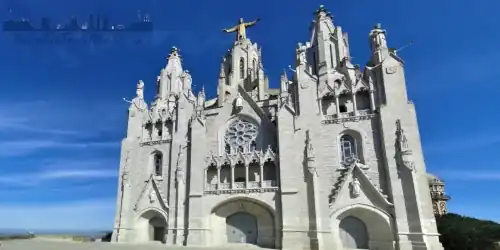
Sacred Heart Of Jesus Temple Tibidabo chuch and viewpoint
Modern Minor Basilica with Romanesque fortress crypt from 1911 and neo-Gothic Main church from 1951. viewpoint at the base of the Crowning Jesus statue
Read more >
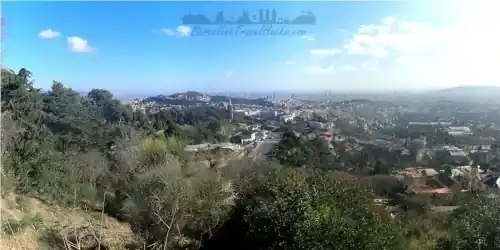
Barcelona to Tibidabo via forest path and Fabra Observatory
EASY 3.44Km forestal path route from Barcelona FGC Av. Tibidabo to Tibidabo Church, viewpoint and parc de atraciones via Observatori Fabra
Read more >
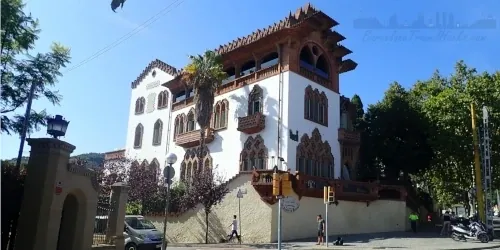
Avenida Tibidabo historic street and Grand houses
Avenue from Plaza John F Kennedy to foot of the Collserola hills that has many former grand modernist houses. Most are converted to private medical clinics
Read more >
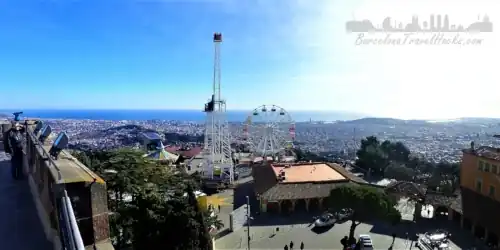
Tibidabo Amusement Park - Parc d'Atracciones Tibidabo
Mountain top amusement park with modern & vintage fairground rides at Mount Tibidabo. Tips, transportation to the top (funicular), tickets & hours
Read more >
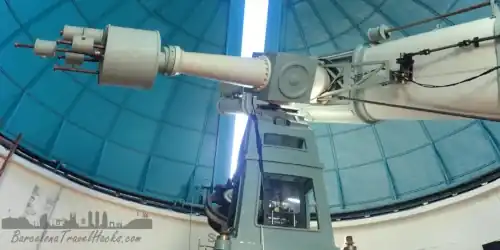
1904 Fabra Observatory for study of asteroids and comets
Historic 1904 fully functional observatory by architect Josep Domenech i Estapa. Observatory offers guided visits and summer evening dinner & stargazing
Read more >
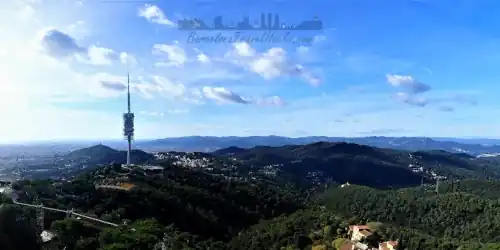
Torre Collserola Viewpoint Visits
Built as a TV transmission hub for the 1992 Olympic venues. One floor is a panoramic viewpoint. Tickets and visit info
Read more >
